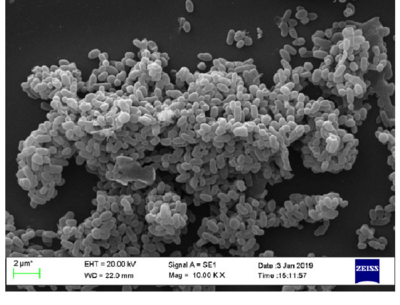
Search
Akkermansia muciniphila

Akkermansia muciniphila is a human intestinal symbiont, isolated from human feces. It is a mucin-degrading bacterium belonging to the genus, Akkermansia, discovered in 2004 by Muriel Derrien and Willem de Vos at Wageningen University of the Netherlands.: 1474 It belongs to the phylum Verrucomicrobiota and its type strain is MucT (=ATCC BAA-835T =CIP 107961T). It is under preliminary research for its potential association with metabolic disorders.
Morphology
A. muciniphila is a gram-negative, strictly anaerobic, non-motile, non-spore-forming, oval-shaped bacterium.
Ecology and metabolism
It colonizes the gastrointestinal tract of humans and other animals and can be found within the intestinal mucosal layer of the epithelial crypts as well as in the caecum. It specifically resides at the oxic-anoxic interface. A. muciniphila is found in about 90% of healthy humans, makes up about 1% to 3% of the fecal microbiota and colonizes the gut during the first year of life. Its prevalence can decrease with age or in disease states.
A. muciniphila is able to use mucin as its sole source of carbon, nitrogen and energy, and is hence considered a specialist. It starts the mucin degradation process by removing fucose and sialic acid capping sugars from the end of the mucin O-glycan chain with fucosidases and sialidases, respectively. A. muciniphila can then get access to the de-capped O-glycans and the mucin peptide chain, both of which it can utilize as an energy source. The released monosaccharides are distributed to the environment where other mucus-associated gut bacteria can utilize them. This way A. muciniphila contributes to nutrient-sharing in gut associated microbial communities. Mucin degradation can also lead to the production of beneficial products such as short chain fatty acids which aid in growth of other bacteria and maintain healthy mucus turnover. It also maintains microbial balance by competing with and inhibiting the over-growth of other mucin degrading bacteria. A. muciniphila is culturable under anaerobic conditions on medium containing porcine gastric mucin or synthetic medium containing protein source with glucose, N-acetylglucosamine and N-acetylgalactosamine.
Genomics
The circular chromosome of the type strain contains 2,664,102 base pairs and its proteome contains 5644 unique proteins.
A. muciniphila strain Urmite was sequenced in its entirety from a human feces sample.
Human consumption
Oral Akkermansia muciniphila, either live or pasteurized, "are safe and well tolerated in overweight and obese individuals." However, its safety for use as a treatment during disease states is unestablished.
The European Union has recognized pasteurized Akkermansia muciniphila MucT as a novel food, provided the cells are killed beyond the limit of detection.
References
Further reading
- Derrien, Muriel; Collado, M. Carmen; Ben-Amor, Kaouther; Salminen, Seppo; de Vos, Willem M. (2008). "The Mucin Degrader Akkermansia muciniphila Is an Abundant Resident of the Human Intestinal Tract". Applied and Environmental Microbiology. 74 (5): 1646–1648. Bibcode:2008ApEnM..74.1646D. doi:10.1128/AEM.01226-07. PMC 2258631. PMID 18083887.
External links
- "Akkermansia muciniphila" at the Encyclopedia of Life
- Type strain of Akkermansia muciniphila at BacDive - the Bacterial Diversity Metadatabase
Text submitted to CC-BY-SA license. Source: Akkermansia muciniphila by Wikipedia (Historical)
Owlapps.net - since 2012 - Les chouettes applications du hibou


